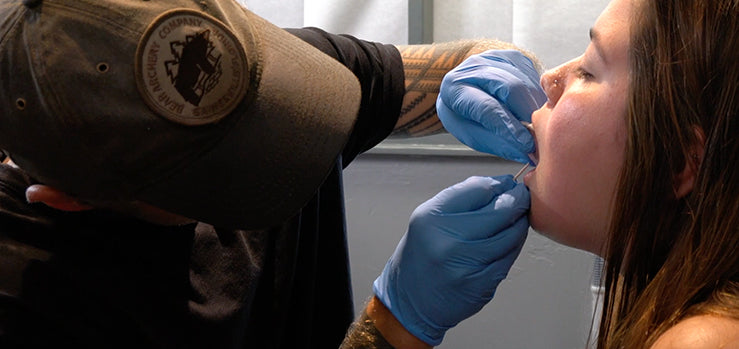Tongue Piercing Information & Aftercare
Tongue Piercing Jewelry
When getting your tongue pierced it will most likely be pierced at a 14 gauge or a 12 gauge. it is easier to find jewelry in a 14 gauge, but often times others like the size of the 12 gauge, making it a personal preference. Once the tongue has healed you can wear 14 gauge or 12 gauge jewelry, it doesn’t matter. When it comes to length, you will initially be pierced with a longer barbell. Most piercers will use a barbell that is 16 mm in length and this will give the tongue room to start swelling. It is always better to start with jewelry that is longer in length, especially in piercings where there is a large amount of swelling. After the piercing is healed piercer will recommend downsizing the barbell. A smaller barbell will keep the teeth and gums in better shape. It will prevent the teeth from chipping and the enamel from wearing down. It also promotes better oral health because it will not wear down the gums. This is something that is recommended but not mandated.
Some people prefer longer jewelry or a longer bar, if that is your preference it’s important to aware of your jewelry and be cautious that it doesn’t catch on anything or hit your teeth. There are many different options for jewelry, its best to leave the original jewelry in until the piercer downsizes the bar or determines that it is completely healed.
The Healing Process
The tongue is one of the faster healing piercings. The healing time is three to four weeks, unless there is something that happens during the healing process, such as irritation. The tongue is made up of two muscles and wrapped in mucus membranes. When the tongue professionals aim pierce between the two muscles. In general, mucus membranes swell a lot, this is why there is a lot of swelling seen in lip piercings, and nose piercings. A tongue piercing is more prone to swelling then most other piercings because it has more mucus membranes then the nose or the lip. Even though this piercing can be uncomfortable while healing it is important that the barbell be kept in the tongue through the entire 3-4 weeks. The tongue will close up or heal very quickly if it is left with no jewelry.

According to Professional Piercers, the first three days after getting your tongue pierced are going to be the days when you will encounter maximum swelling. After the third day the swelling will start to taper off, and you will feel more comfortable as time continues. In the first two or three days you should expect some slurred speech, and you might feel sore or uncomfortable. The first three days go quick, and it does get better so hang in there! There is about a week of overall swelling and by the second week your tongue will feel as if it is going back to normal. During the second week there will still be residual swelling, but nothing like the first week. The third and fourth week shouldn’t be bad, and your tongue should be back to normal.


What to Avoid
During the first three to four weeks of healing it is important to be realistic and use common sense with your tongue piercing. Avoid things such as spicy foods and foods that are high in citrus. High citrus foods and drinks include, oranges, orange juice, lemon, etc. For the first few days start with softer foods. If you eat or drink these types of foods, it can cause irritation in the piercing and it can make it swell. This will prolong the healing process. Drink cool water or ice water during healing. Make sure to avoid both kissing and oral sex because you have an open wound in your mouth. Both kissing and oral sex can bring in potentially harmful bacteria that can possibly enter that open wound. Make sure to wait until the healing process is over to do any of these things, waiting will make for a quicker and more pleasurable healing process.
Tongue Piercing Aftercare
The aftercare routine for the tongue piercing is relatively easy, but it is crucial to keep up with your cleaning regime throughout the four-week healing period. It is important to avoid all mouthwash with alcohol in it. Professional Piercers recommend the mouthwash Biotene, it can be found at most major retailers or drug stores. During the day you can make your own Salt Soak to rinse with. This is one of the easiest piercings to perform a salt water rinse on because of its location. Buy a gallon of distilled water from your local grocery store or pharmacy, and non-iodized or all-natural sea salt. It can be found in the salt isle in the grocery store. It is important that the sea salt label reads “Non-iodized” or “Pure”. In order to make the solution add four teaspoons of the non-iodized sea salt to a gallon of distilled water. After mixing it, you can pour it into a small water bottle to take with you on the go (It’s easier to pour your already mixed solution into a water bottle, rather than trying to mix the improper amount in a small bottle). Complete a thirty second rinse after breakfast, lunch, and dinner.
This rinse consists of pouring the solution into your mouth and “swishing” it around for thirty seconds to clean the piercing, and then spit it out. If you are a smoker it might be a good idea to quit during the healing time, or make sure that you are doing a salt rinse every time you smoke. This is why a small water bottle is coinvent, you can take it along with you if you are going out to eat or know that you will be smoking. Tongue Piercings are pretty easy to take care of, and after the swelling period it should be smooth sailing from there.
Always remember, if you have questions about your piercing it is best to go to a Professional Piercer or a Medical Professional.




